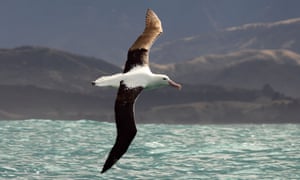https://www.theguardian.com/environment/2019/jan/31/industrial-fishing-ushers-albatross-closer-to-extinction-say-researchers?fbclid=IwAR3eEv820-6dsC2C_9lkEHUjIHolNAhliw1fh50yiDn1XdY3-tvmXHHjFpA
Industrial fishing ushers the albatross closer to extinction, say researchers
Satellite data suggests protection measures are being ignored as huge fishing lines snare endangered seabirds
Industrial fishing vessels that accidentally kill tens of thousands of albatrosses each year routinely ignore regulations designed to save the birds from extinction, according to research.
Using satellite data, investigators found that vessels employing longline fishing techniques showed a “low level of compliance” with measures to reduce albatross deaths.
Longliners target tuna and other species, but their fishing lines – which can be up to 80 miles long – also unintentionally trap, drown and harm seabirds, as well as turtles, dolphins and other marine life, a process known as “bycatch”.
Modern fishing methods have been identified as a major danger to plummeting albatross populations, threatening to drive almost three-quarters of all species to extinction, said Birdlife International, who undertook the research in conjunction with Global Fishing Watch.
Under a red list compiled by the International Union for Conservationof Nature, 15 out of 22 albatross species are considered endangered.
The study, which drew on satellite data to map the behaviour of longliners in the Indian, Atlantic and western central Pacific ocean, revealed that just 15% of the vessels used a measure known as “night-setting”, which involves putting lines down at night. The technique is one of three mitigation measures designed to protect albatrosses, which only feed during the day.
The findings offered a stark contrast with reports given by countries to fisheries watchdogs that suggested night-setting was used by between 29% and 85% of fleets.
“The results are very disappointing,” said Stephanie Winnard, a biologist with the albatross task force, a specialist unit set up by Birdlife International and the Royal Society for the Protection of Birds. “By this stage you would expect a lot more vessels to be using night setting.”
The aim of the research was to encourage best practice, to which end the results will be shared with the countries whose vessels were studied.
Albatrosses, petrels and other seabirds are “irresistibly drawn” to the trailing, baited longlines, said Winnard. Each year, an estimated 100,000 birds are hooked and drowned by longline and trawl fisheries.
“This level of bycatch in the fishing industry is hugely unsustainable for birds that can take up to 10 years to start breeding,” said Winnard, who added that the findings were “truly powerful” for the way the data shed light into the “opaque world” of global fisheries and their impact on ocean biodiversity.
“No one is going to report they are not sticking to the rules or they are killing seabirds, so we now have this independent way of measuring compliance,” said Winnard. “This information has never before been public. It is usually kept behind closed doors. It will promote transparency and hold countries to account. It is the first time we’ve been able to see what is happening on individual fishing boats.”
The researchers used vessels’ satellite data to examine the way 201 ships were moving, as well as the speed and direction of travel, in order to determine when fishing lines would be put down.
Regulations laid down by the five Regional Fisheries Management Organisations that regulate tuna fisheries where albatross are found generally stipulate that two out of three mitigation measures must be used. The other methods include weighting lines to ensure they sink faster and using streamer lines to scare seabirds away. The regulations have been in place for between five and 10 years, depending on the region, but the RFMO rely on self-reporting by the ships.
However, the international Agreement on the Conservation of Albatrosses and Petrels, introduced in 2004, suggests all three mitigation methods should be used.
A study published in 2011 estimated the bycatch of seabirds of longline fisheries to be between 160,000 and 320,000 annually.


沒有留言:
張貼留言